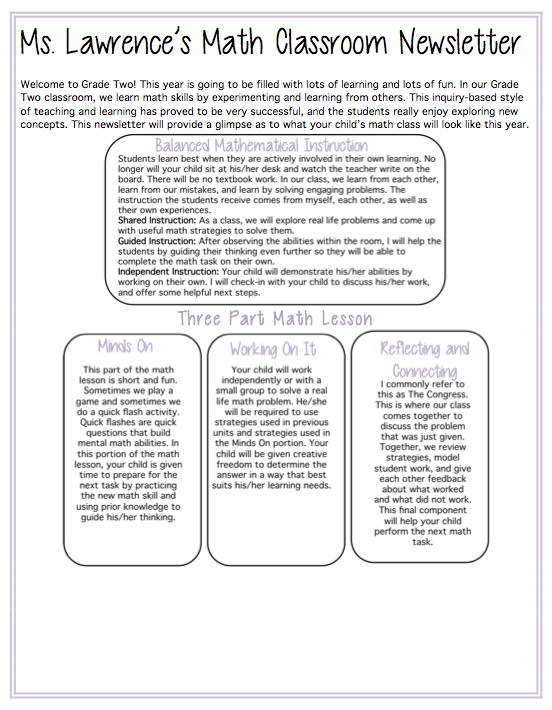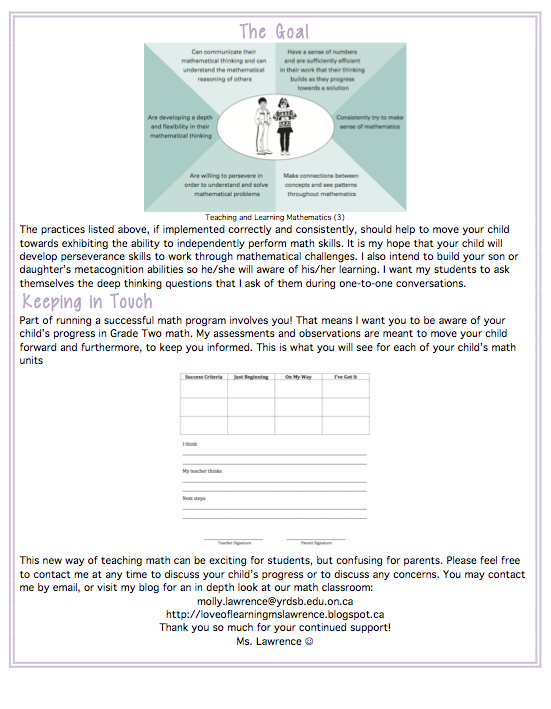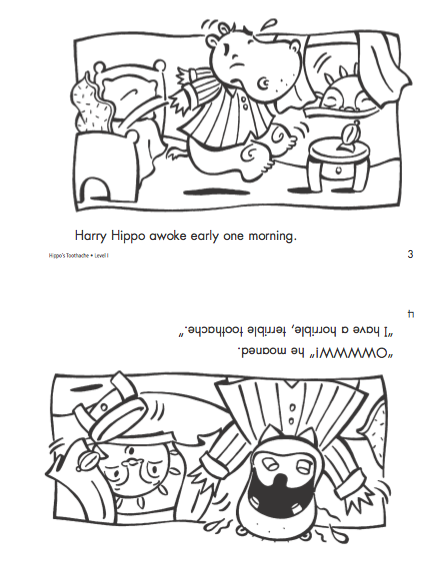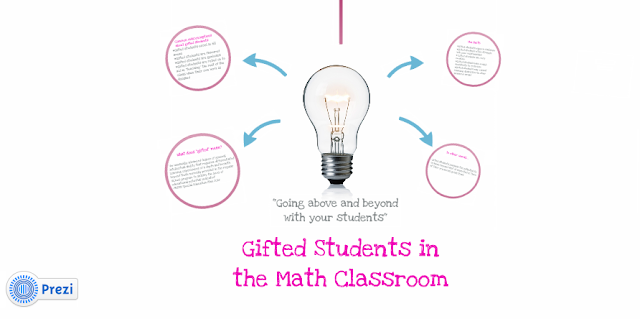
Tuesday, May 28, 2013
Balanced Mathematics
If you're a teacher, you're
familiar with Balanced Literacy, but have you heard of Balanced Mathematics?
You probably do it without realizing this is what it is called. Much like
Balanced Literacy, there are different forms of instruction, each with a different
level of teacher support and scaffolding.
I co-created this
presentation with a peer. Take a look to learn more about Balanced Mathematics!
Monday, May 27, 2013
Communication
It seems we live in a world where
communicating with one another creates more anxiety and fear than it ever used
to in the past. Remember the days when you’d just call up your friend, or walk
over to your neighbour’s house to visit? You’d chat with whoever you
encountered first, be it their mother, father, estranged relative….Now we tend
to text people so we don’t actually have to talk. We call cell phones rather
than the house phone because we don’t want to have to speak to anyone else. We
send Facebook messages and iMessages because we can see when the recipient has
viewed our messages. I’m not saying I’m not guilty of any of these examples. It’s
not so much a matter of feeling anxious and nervous about the direct
conversation, it’s moreso about the convenience of sending a message and not
having to make sure the other person is there to respond. Although, I really hate leaving messages. I usually
rehearse what I’d say in the voicemail before I call. Nothing’s more
embarrassing than a bad voicemail.
As a classroom teacher, communication is
crucial, and communicating with parents is a biggie. The better your contact is
with the parents, the stronger the support system you will have. Given the
change in the way we teach mathematics these days, a lot of families struggle
with how their kids are learning. Inquiry based math is very foreign to many
parents, so the more you keep them informed, the smoother your classroom will
run. After all, if you have a lot of support from parents, it is likely the
same practices will be reinforced at home.
It’s impossible to keep all parents up to
date on a close, personal level. There’s not enough time to call every parent
once a week. It’s too impractical. Newsletters are a great way to keep open
communication with parents. It’s the best way teachers can consistently keep
parents informed about the goings on in their son or daughter’s classroom.
Providing a newsletter that outlines your programming is a great way to start
off the year because it introduces and familiarizes parents with how your
classroom will run. Here is an example of a newsletter I would send out to
parents. I made sure I wrote it in family-friendly language so it’s inviting
rather than intimidating.
We’ve covered communicating with people
outside the classroom. But what about communication among students?
Specifically, what about how students communicate their learning? We all know
that we need to differentiate the ways in which students are able to
communicate their thinking for assessment and evaluation purposes. Let them be
creative and represent their thinking in a style that works for them! I’m
talking about something different. We need to encourage students to communicate
their thinking processes so we can
understand their misconceptions. This is a clever little video that shows how
two men approach a division question. Notice how they communicate with one
another:
Neither man tries to understand the other’s
thinking. We need to encourage our students to listen and question one another,
rather than just trying to prove the correct answer. Of course, this is the
destination at which we want them all to arrive; however we can’t fix the
common misconceptions by simply ignoring them. When I congress with the class,
I like modeling an answer that is incorrect. I have the student explain his/her
thinking to the class. We all observe and follow his/her train of thought.
Together, we determine why this method does not work, and we collaborate to
find a strategy that does work. I think when we take the time to appreciate
another’s efforts, the communication among students will grow to be more
positive and helpful. It’s not a test to see who can get the right answer; it’s
a test to see how we can work together and talk together to overcome
challenges.
Thursday, May 23, 2013
A Surprise Visit
When I graduated Teacher’s College last April, there were no
teaching jobs in York Region. I could have travelled and moved to another board
or even another province or country, but I really didn’t want to move. It
wasn’t because I didn’t want to move away from everything I knew (although that
was a big reason); it was because I really wanted to teach in York Region. I
grew up there, I did my teaching placements there, and I knew that was where I
wanted to teach. I decided to stay until the end of the year and volunteer
until my summer job started. When there were still no job postings in
September, I continued volunteering on a full time basis. That’s how I gained
so much knowledge and experience in teaching Grades One and Two. I was
fortunate enough to be able to teach and learn alongside Melissa and Stacia.
Then, one chilly February day, the occasional teacher’s list came out for the Primary and Junior divisions, but only if you had music qualifications. Coincidentally, I had just finished my Instrumental Music Part 1 AQ in December. I applied, and in March I was interviewed. By the end of April on a Friday afternoon, I signed my occasional teaching contract. I went back to volunteer the following Monday, thinking that whatever days I wasn’t supplying, I’d still go in to volunteer. I was called out that afternoon and hadn’t been back since.
Having been volunteering all that time, the steady work and
pay cheque was wonderful. I was getting calls every day and meeting lots of new
students and teachers. It was bitter sweet though because I didn’t get to see
my students anymore, let alone say a proper goodbye. I had no idea I would be
so busy right away!
I keep in touch with Melissa, so I told her I wanted to pop
by for a visit. I wrote the kids a letter, telling them how much I missed them,
and that sometime soon, I would try to come in for a visit. Melissa read them
this letter, but did not let them know of my impending visit that we had
arranged. Even not knowing when I’d be by, they all had some surprises ready
for me when I dropped by this afternoon. You should have seen it. I knocked on
the door, they looked at me, did a double take, and then 21 little bodies were
running at me, yelling, “Ms. Lawrence! Ms. Lawrence!” and forming the best
group hug known to mankind. They were all asking me to look at their smiles,
where in the last month, each kid averaged three new missing teeth. I couldn’t
help but tear up at the love and cuteness that surrounded me.
I wish I could have stayed longer, but I had a lot of
running around to do today (which is why I had booked the day off). I promised
them I would come back again closer to the end of the year. I would assume that
in the last week of school, occasional teachers won’t be needed as much, so
maybe I can get a few more days in with the kiddos that made the past year as
great as it was.
I leave you with pictures of some of their little gifts to
me. There’s something about Primary spelling and drawing that just melts my
heart.
This one made me laugh...
| Girl: "This is the school and you're standing in it, eating an ice cream cone. I forgot to draw your head, though." |
 |
| Popsicle sticks and Disney princesses. A creative masterpiece! |
| A little bit of tape and some white pipe cleaners and you've got yourself a white rabbit |
| Our class :) |
 |
| I love how some of them spell my last name |
Allow me to translate...
| "I'm happy to see you. You're the best teacher I had ever had. I'm glad to see you. It has been a long long time ever since I saw you" |
My personal favourite...
A bracelet with a clamp so I can carry my keys on my wrist. Too cute!
Teacher by Day, Tutor by Night
Ever since I was 14, I have privately tutored kids from my
home. In 2010, after a break from tutoring, I took on a little girl who was in
kindergarten. She has been my longest client, as she is now in Grade 2. Since
then, I have expanded my clientele list by taking on four more children.
Tutoring five kids doesn’t sound like a lot when I teach up to 30 kids at once
at school. But five kids is a lot when they all have their own programming,
their own needs, and their own subject matter, depending on their grade levels.
Working in a school September through June makes it really easy to borrow
resources to use at home with the kids. When I work with them in the summer, I
suddenly panic because I can’t find any good books that match their reading
levels. I tend to focus the summer more on writing; but it’s such a waste when
I’ve spent all year moving their reading abilities up.
The other night, it dawned on me to look into some websites
to which many schools subscribe. One in particular is Reading A-Z.com. It cost me a penny or two, but the subscription is well
worth it because I know I will be using it all summer long. Even throughout the
school year for that matter. Reading A-Z provides PM and DRA leveled books,
available to print. There are literally hundreds of books to choose from. And
what’s more, each book comes with many student and teacher resources and
activities.
Tonight, I used Hippo’s Toothache with my second
grader and we both loved it. It was the perfect level for her, she gets to take
the book home, and she can colour the pictures. I loved it because in addition
to having easily found the perfect book, there were so many activities that
accompanied the story. I ended up downloading a high frequency word game. She
loved it! Probably because she won. Anyways, Reading A-Z makes guided reading a
breeze when your access to leveled books is limited. If you use PM and DRA
books regularly, I’d say it’s worth the annual $90.00 payment. And right now,
you can get $10.00 off! I think that’s what sold me.
Hopefully your school has its own subscription and you can
access it for free. If not, it might be a good investment for those of you like
me, who teach by day and tutor by night.
Just print, fold, and staple. (http://www.learninga-z.com/)
Saturday, May 18, 2013
Pictures, Numbers, and Words
This is a really interesting article [click HERE] on the importance of using pictures to represent a full understanding of a math concept. When I give my students a math problem to solve, I always tell them to represent their thinking in pictures, numbers, and words. It's astonishing how many will develop an anxiety when they think about all that drawing they'll have to do.
Do I expect my students to draw me 57 detailed little books, including a little scribble where the title would go? Of course not! We don't have all day.
I teach them that "Pictures don't always mean pictures".
At this point there are a lot of seriously confused and concerned faces.
"Pictures," I tell them, "can be diagrams. They can be quick drawings that represent a number".
They're a little less frightened, and they're willing to hear me out.
"I can represent 57 books with a few circles. Let me use my Friendly Numbers (1, 5, 10-because these are easy to work with in my head) to represent the parts of 57. This picture here represents 10 books."
Question:
I had 57 books on my book shelf. I have read 12 of them. How many more books do I need to read so that they have all been read?
I teach them that "Pictures don't always mean pictures".
At this point there are a lot of seriously confused and concerned faces.
"Pictures," I tell them, "can be diagrams. They can be quick drawings that represent a number".
They're a little less frightened, and they're willing to hear me out.
"I can represent 57 books with a few circles. Let me use my Friendly Numbers (1, 5, 10-because these are easy to work with in my head) to represent the parts of 57. This picture here represents 10 books."
The students begin to relax. They even start looking excited because they know what I have to do next. They decide to help me out. Even though I love the enthusiasm, I have to remind them to raise their hands. There's no room for excess chaos in the math classroom.
"How can I represent my 57 books?"
Together, we come up with this (note: I put the tens in a dice pattern. It makes it easier to instantly see that there are five):
"Using my picture, how can I show that I have read 12 books?"
The kids begin to cross out the parts.
It's decided. I have to read 45 more books in order to finish all the books on my bookshelf.
Sure, I can teach the kids how to line up the numbers and begin subtracting the ones column, then the tens, but I wouldn't be sure they understood why they were doing that. When your students show you their understanding in pictures, you can really see who gets the deeper concepts and who doesn't. 57 is more than just 57. It's 5 groups of tens and 7 groups of ones. Pictures show us this. Numbers alone do not.
Remember to reinforce the point that math pictures are different than art pictures. Mathematicians always try to determine their answers in the most efficient ways. This may take longer than lining up the numbers, but it shows us that our students are able to break apart numbers and see the math question, rather than simply follow a rote process.
Wednesday, May 15, 2013
Guided Reading Strategies
Guided reading is probably the most important element of the literacy block because it's the time you get to sit one on one with your students and assess their reading abilities, doing all you can to move them forward. I love guided reading for this very reason. I learn so much about my students and get to see how well they use the reading strategies I teach them. The thing is, there are so many strategies to use, it can often feel overwhelming for the little readers. I have been fairly consistent verbally identifying the strategies, but for some kids, this can be really hard to remember. For example, they all know what "chunking" is (finding smaller chunks in the word that they already know), but using this strategy may not come to mind without teacher prompting.
That's why I fell in love with these cards I found on The First Grade Parade Website. It's important to understand that I did not create these resources. They are methods I certainly use in my classroom, but the names and adorable pictures are the work of another great teacher. Sometimes having a fun visual can make remembering reading strategies much easier. And it's pretty fun to say "chunky monkey" when you're reading. It really gets the kiddies laughing (which is the best sound in the world)!
I use these cards in my classroom. Maybe you'll enjoy using them too.
Click here to be redirected to the original blog for these items.
That's why I fell in love with these cards I found on The First Grade Parade Website. It's important to understand that I did not create these resources. They are methods I certainly use in my classroom, but the names and adorable pictures are the work of another great teacher. Sometimes having a fun visual can make remembering reading strategies much easier. And it's pretty fun to say "chunky monkey" when you're reading. It really gets the kiddies laughing (which is the best sound in the world)!
I use these cards in my classroom. Maybe you'll enjoy using them too.
Click here to be redirected to the original blog for these items.
Wednesday, May 8, 2013
Learning in the Fast Lane
What comes to
mind when you think of gifted students? Perhaps words like genius, brilliant, or intelligent jump out at you. Maybe you’re one of the many who get intimidating, anxious, or unfamiliar.
Gifted students come in all shapes and sizes, ages, genders, and abilities. As
different as they can all be from one another, one thing usually remains the
same: having gifted students in the classroom can cause a lot of anxiety for
the teacher. But anything is scary and intimidating when you don’t know much
about it.
I used to fear
driving on the 401 because I’m just a small town girl who grew up in a hamlet
where a few stop signs were more than enough to manage traffic. Once I began
driving those major highways and familiarizing myself with the pattern of the
roads, the drive wasn’t all that bad. And let's not forget to give due credit to the iPhone Maps app.
Teaching gifted
students is quite similar. They learn in the fast lane and like to have
multiple opportunities to arrive at their destination. Their thirst for
knowledge and their impressive abilities to exceed normal expectations can send
teachers into a panic! “What if they’re
smarter than me? What do they do if they finish half an hour before everyone
else? How can I prevent the behaviours that stem from their boredom?”
As Francis Bacon once famously said, “knowledge is power”, and this truth can
be applied to the student as well as the teacher.
Provide the
gifted students with the opportunities they need to be successful and watch them
excel beyond your wildest dreams. Educate yourself on the needs and
characteristics of your gifted students and you’ll be able to provide the best
learning environment for those children.
It's important to remember that gifted students are very similar to students with learning disabilities. Both parties have been formally identified and have Individual Education Plans designed specifically for their needs. The same effort you put towards differentiating your instruction for a child with learning disabilities should be applied to a child who is gifted. Both are exceptional meaning they both need accommodations and modifications in their programming.
It's important to remember that gifted students are very similar to students with learning disabilities. Both parties have been formally identified and have Individual Education Plans designed specifically for their needs. The same effort you put towards differentiating your instruction for a child with learning disabilities should be applied to a child who is gifted. Both are exceptional meaning they both need accommodations and modifications in their programming.
The
following is a short presentation that educates you on gifted children in the math classroom. I used an online
program called Prezi; I have seen it used many times, but had never used it
myself. After a few hours of clicking and exploring, I came up with a simple,
yet informative presentation on learning how to provide an inclusive learning
environment for the gifted child. Just follow the few short instructions before
beginning and enjoy!
1. Click on the picture below. You will be redirected to the Prezi website
2. Begin the presentation by clicking the Fullscreen icon at the bottom right corner of the video
3. Once the music begins to play, navigate at your own pace using the arrow keys
Subscribe to:
Posts (Atom)























